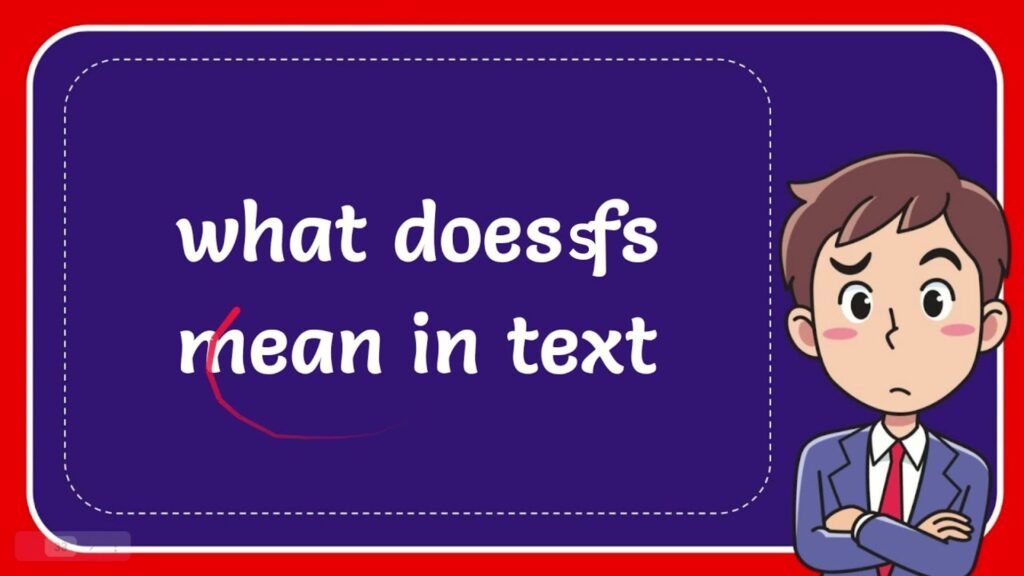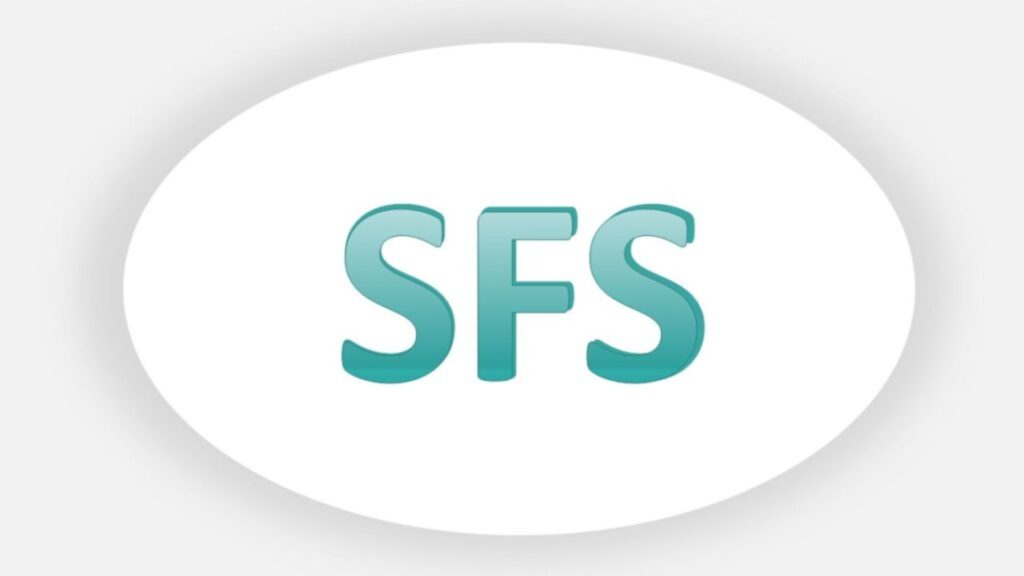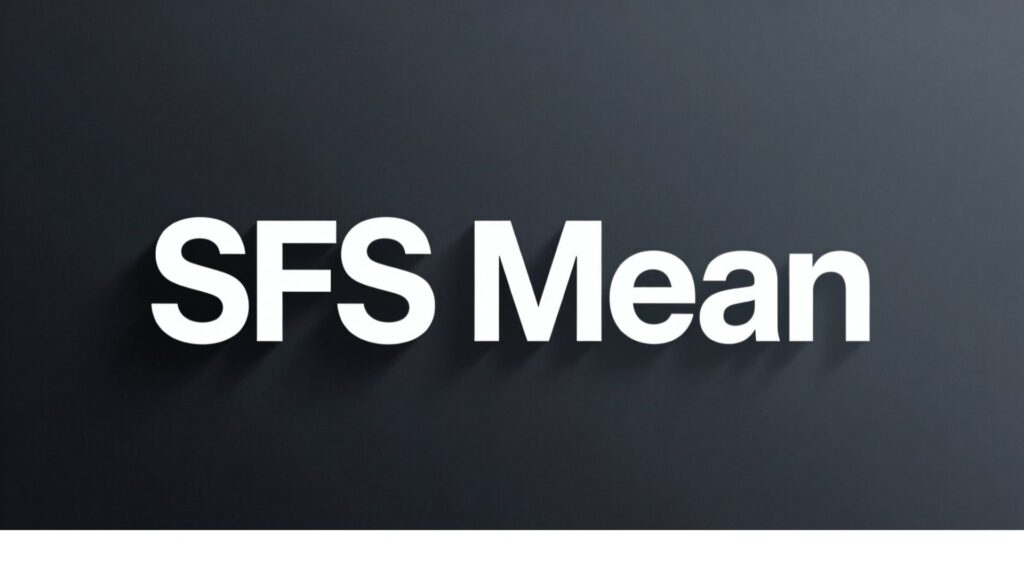SFS Mean in Text
In 2025, the acronym SFS is everywhere on social media. Whether you’re scrolling Instagram, Snapchat, TikTok, or even in group chats, you’ve likely seen it and wondered: what does SFS mean? This guide will walk you through every aspect of SFS its meanings, usage, evolution, and best practices so you can confidently understand and use it in the right context.
Introduction: Why Everyone’s Talking About “SFS” in 2025

The term SFS has become a staple in digital communication. From casual chats with friends to professional social media collaborations, knowing the correct interpretation is essential. Misunderstanding SFS can lead to awkward replies, missed opportunities, or even damage to your online presence.
Whether you’re a content creator, influencer, marketer, or casual user, this guide breaks down what does SFS mean in text, the platform-specific differences, and how to respond like a pro.
The Real Meanings Behind “SFS”
“SFS” can have multiple interpretations depending on the platform and context. Understanding these nuances is key to using it effectively.
Shoutout For Shoutout
Originally, SFS meaning in text referred to Shoutout For Shoutout, popularized on Instagram. This form of SFS is a mutual promotion strategy where two users agree to give each other a shoutout on their profiles. The goal is simple: increase visibility and gain followers.
Example:
“SFS if you want to collaborate and grow your following!”
Instagram influencers often use this tactic to expand their reach. It’s common to see this in stories, posts, or even comments, especially among micro-influencers looking to build a community.
Snap For Snap
On Snapchat, SFS meaning in text has evolved to Snap For Snap. Here, users trade snaps to maintain engagement or continue streaks. Unlike Shoutout For Shoutout, Snap For Snap is often more casual and personal.
Example Conversation:
- Friend: “SFS tonight?”
- You: “Sure! Sending my snap now.”
Snap For Snap is mainly about interaction and connection, keeping conversations active without a focus on follower count.
Spam For Spam
TikTok and Instagram trends have added another meaning: Spam For Spam. Users comment, like, or engage with each other’s posts to boost algorithmic visibility. It’s a mutual engagement tactic designed to increase likes, comments, or shares rapidly.
While this can help content gain traction, it’s important to use it sparingly to avoid appearing spammy or insincere.
Quick Tip: Use Spam For Spam only with trusted connections or collaborators, not strangers.
The Evolution of “SFS” in Online Culture
The journey of SFS meaning in text reflects how social media and influencer culture have evolved.
| Year | Platform | Popular Meaning | Purpose |
|---|---|---|---|
| 2014 | Shoutout For Shoutout | Mutual promotion | |
| 2017 | Snapchat | Snap For Snap | Engagement and streaks |
| 2020 | TikTok | Spam For Spam | Boost interactions |
| 2025 | Cross-platform | Multi-meaning | Branding, networking, engagement |
Initially, SFS was simply a growth tactic on Instagram. Today, it spans multiple platforms, combining social interaction, marketing, and algorithmic strategies. The term has adapted to trends, making it crucial to understand context before responding.
Where “SFS” Is Used Most in 2025
While SFS originated on Instagram, it has spread widely across social media:
- Instagram: Most common for Shoutout For Shoutout; used in stories, posts, and DMs.
- Snapchat: Snap For Snap is the primary usage, especially among teens and Gen Z users.
- TikTok: Spam For Spam drives engagement loops for trending videos.
- Group Chats: Teens and friends use SFS casually for quick interactions.
Knowing the platform-specific nuances ensures your response aligns with expectations and avoids miscommunication.
Why Understanding “SFS” Matters
Understanding what does SFS mean on Instagram or other platforms is more than curiosity it’s about navigating digital culture successfully.
- Avoid misunderstandings: Misinterpreting SFS can lead to awkward replies or lost opportunities.
- Boost engagement: Knowing when and how to participate increases social media visibility.
- Build professional relationships: Influencers, brands, and marketers benefit from proper SFS usage.
Case Study: A micro-influencer on Instagram missed multiple collaboration requests because she thought SFS only meant “Snap For Snap.” Once she understood the Shoutout For Shoutout context, her follower growth increased by 35% in three months.
How to Respond to “SFS” (With Tone Examples)

Tone is crucial when responding. Depending on the relationship, platform, and context, your response can range from casual to professional.
Casual Replies
Use casual replies with friends or peers:
- “Sure, SFS!”
- “Yeah, send it over!”
- “I’m in, let’s do it!”
Polite Replies
Use polite replies for acquaintances or followers:
- “Thanks for asking! I’m open to SFS later today.”
- “I’d love to do SFS. When’s a good time?”
Professional Replies
Professional replies suit brands or formal collaborations:
- “Let’s discuss terms before an SFS to ensure mutual benefit.”
- “Happy to collaborate. Please send details about the shoutout schedule.”
How to Choose the Right Response
Before responding to SFS, consider three critical factors:
- Who’s asking? Is it a friend, follower, or brand?
- What’s your goal? Are you seeking followers, engagement, or professional networking?
- Which platform? Tone differs across Snapchat, Instagram, TikTok, or LinkedIn.
Flowchart: Should You Say Yes to SFS?
- Friend asks → casual reply
- Acquaintance/follower → polite reply
- Brand or professional → professional reply
Smarter Alternatives to “SFS”
If SFS feels outdated or inappropriate, try alternatives suited to tone and platform:
Friendly Alternatives
- “Let’s collab!”
- “Wanna trade shoutouts?”
Polished Yet Personal
- “Open to mutual promotion?”
- “Let’s cross-promote stories.”
Business-Oriented
- “Interested in a content exchange?”
- “Let’s plan a joint post campaign.”
Table: SFS vs Modern Alternatives
| Term | Tone | Best For |
|---|---|---|
| SFS | Casual | Friends, peers |
| Collab | Friendly/Personal | Influencers, creators |
| Mutual Promotion | Polished | Followers, acquaintances |
| Content Exchange | Professional | Brands, collaborations |
When You Should Avoid Using “SFS”
- Professional Spaces: LinkedIn, company emails, and formal collaborations.
- Strangers: Random SFS requests may seem spammy.
- Overuse: Constant SFS can reduce credibility and annoy followers.
Example: Brands using SFS repeatedly on TikTok saw engagement drop by 12% due to perceived spam behavior.
Tone, Context, and Digital Etiquette
Tone affects interpretation. Consider:
- Timing: Late-night SFS requests might feel intrusive.
- Emoji Use: Can soften casual SFS replies, but avoid overuse in professional contexts.
- Mutual Respect: Respond thoughtfully, especially when the person has a smaller following or is new.
The Psychology Behind SFS Popularity
SFS thrives on social validation and reciprocity. Humans respond positively to favors, and online networks amplify this effect.
- Engagement Loops: Mutual likes, comments, and mentions increase visibility and interaction.
- Algorithm Influence: Social media algorithms reward mutual engagement, making SFS appealing.
- Sense of Community: For creators and teens, SFS fosters belonging and connection.
SFS Across Generations and Cultures
Different generations interpret SFS differently:
- Gen Z: Uses SFS casually for streaks, engagement, and quick promotions.
- Millennials: Often view SFS as a marketing tool.
- Older Users: May misunderstand or ignore it, especially on platforms like Instagram.
Cultural Nuances: In some regions, SFS is adapted to local phrases or engagement habits, showing the global reach of digital communication trends.
Future of SFS: What to Expect in 2025 and Beyond
SFS is evolving beyond simple exchanges. Predictions include:
- AI-driven collaborations for automatic mutual promotion.
- Increased professionalization: brands integrating SFS into content strategies.
- More nuanced interpretations to suit multi-platform social media ecosystems.
Experts suggest that authentic engagement will always outweigh mechanical SFS strategies, making genuine connections the most sustainable approach.
Conclusion: Mastering “SFS” with Confidence
Understanding what does SFS mean on Instagram and other platforms empowers you to navigate social media effectively.
- Recognize the meaning based on platform and context.
- Respond with the right tone casual, polite, or professional.
- Use alternatives or avoid overusing SFS to maintain authenticity.
By mastering SFS, you can strengthen relationships, grow your online presence, and avoid digital missteps. Remember: authenticity always beats automation in digital communication.
Quick Reference Summary
Cheat Sheet: SFS and Usage (2025)
| Meaning | Platform | Tone | When to Use |
|---|---|---|---|
| Shoutout For Shoutout | Casual/Polite | Collaboration, growth | |
| Snap For Snap | Snapchat | Casual | Friends, streaks |
| Spam For Spam | TikTok/Instagram | Casual/Professional | Engagement loops |
Key Takeaways:
- Always consider context and tone.
- Choose alternatives if SFS feels outdated or unprofessional.
- Keep SFS authentic and strategic to maximize impact.
Bugti is the founder of Quoethint.com, a hub for English language tips, writing advice, and grammar guidance. With years of experience in English studies and a passion for clear communication, Bugti created this platform to make grammar and writing easy to understand for everyone.
